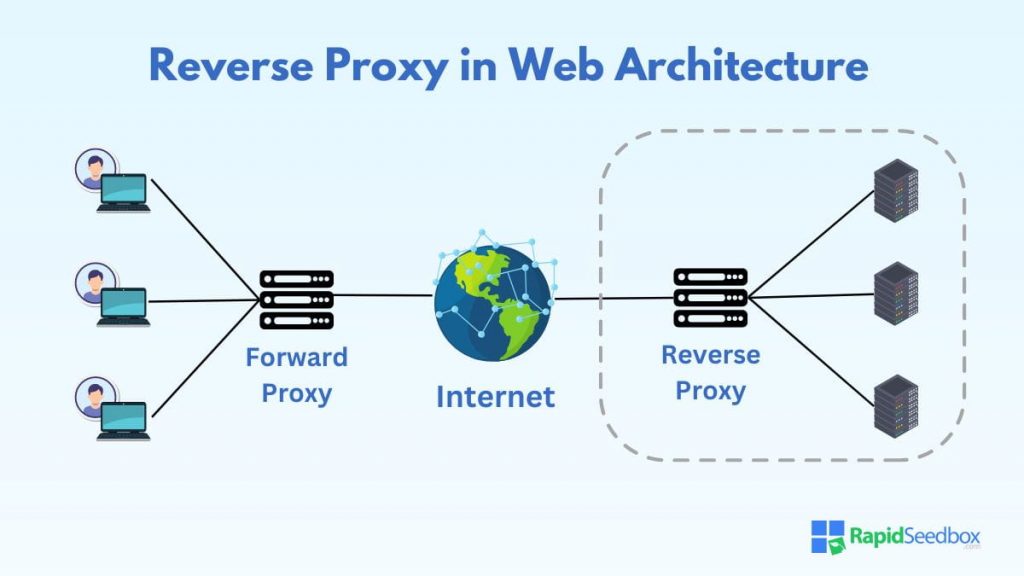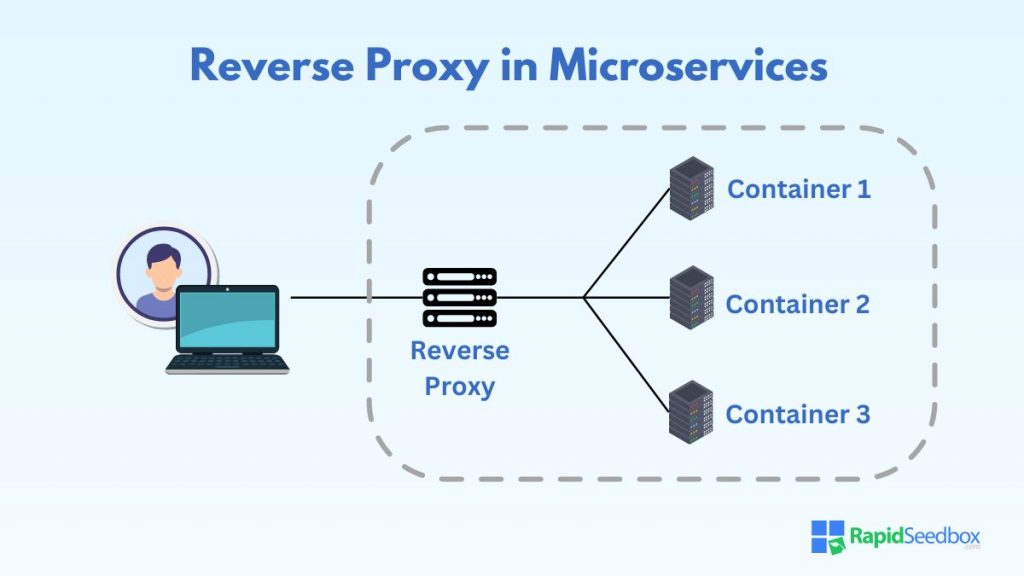The web’s growth has gone out of hand, and managing and securing online services is becoming more challenging. While several types of proxy servers work to circumvent these challenges, one of the most vital is the reverse proxy. This article digs deeper into how reverse proxies work and their invaluable role in modern web architecture.

Table of Contents
- What is a Reverse Proxy?
- How Reverse Proxies Work
- Key Components of a Reverse Proxy
- Why a Reverse Proxy is Necessary
- Better Security
- Improved Load Handling
- Encryption and Decryption
- Enhanced Availability and Redundancy
- Who Uses Reverse Proxies?
- Websites
- Content Delivery Networks
- Companies with Microservices Architecture
- API Providers
- Examples of Reverse Proxy Applications
- Nginx
- Apache HTTP Server
- HAProxy
- AWS Elastic Load Balancer
- Frequently Asked Questions
- Final Thoughts
1. What is a Reverse Proxy?
A reverse proxy is a server that sits between you and a website’s server. It is responsible for sending your requests to the website’s server and returning the website’s response. Thanks to this role, reverse proxies improve security and streamline traffic.
a. How Reverse Proxies Work
A typical reverse proxy setup involves three main components:
- Client: The end user (you) or device requesting information or services.
- Proxy Server: This intermediary server receives your request, processes it, and forwards it to one of the backend servers.
- Backend Servers: These servers have the resources you’ve requested, such as the information necessary to render a web page.
Initially, the client sends a request to the reverse proxy server. The proxy server evaluates the request and sends it to the correct backend server. Once the backend server processes the request, it sends a response to the proxy, which sends it back to the client.
b. Key Components of a Reverse Proxy
Several key components are involved in the architecture and functioning of a reverse proxy:
- Load Balancer: This crucial part of the reverse proxy distributes incoming traffic across multiple backend servers, ensuring no single server is overwhelmed.
- SSL/TLS Termination: The reverse proxy can handle SSL/TLS encryption and decryption. This reduces the load on backend servers and ensures secure communication between clients and the proxy.
- Caching: By caching data, reverse proxies further reduce the load on backend servers and improve response times.
- Web Application Firewall: This security layer filters and monitors incoming traffic to protect backend servers from attacks and unauthorized access.
2. Why a Reverse Proxy is Necessary
Nobody adds an extra layer of expensive servers for no reason. Reverse proxies are vital in web infrastructure and offer many advantages that improve the Internet’s performance and integrity. This includes:
a. Better Security
Reverse proxies act as a shield between the client and backend servers, masking their identity and location. They also filter incoming traffic, thus blocking malicious requests. This layer of protection helps safeguard backend servers against various cyber threats, such as Distributed Denial of Service (DDoS) attacks.
b. Improved Load Handling
By distributing client requests across multiple backend servers, reverse proxies ensure requests don’t swamp individual servers. This distribution helps maintain optimal performance and availability at any time.
Reverse proxies also cache content. If data requested by a client is already held in the cache, the reverse proxy can respond immediately without sending the request to a backend server.
One final load-handling advantage that reverse proxies offer is data compression. A reverse proxy saves bandwidth and further speeds up performance by compressing content before delivering it to the client.
c. Encryption and Decryption
Handling SSL/TLS encryption and decryption is resource-intensive. Reverse proxies can offload this task from backend servers by terminating SSL/TLS connections, decrypting incoming requests, and encrypting outgoing responses.
This process, known as SSL termination, reduces the load on backend servers and simplifies SSL certificate management. This ensures secure communication between clients and the proxy while improving overall performance.
d. Enhanced Availability and Redundancy
If a backend server fails, the reverse proxy can reroute traffic to other healthy servers, ensuring continuous service availability. This failover capability ensures that users are minimally affected by server failures.
Worried about the security of your online services?
RapidSeedbox proxy servers provide top-notch encryption to protect your data from prying eyes. With our proxy servers, your internet activity is masked, protecting your information from hackers and surveillance.
3. Who Uses Reverse Proxies?
Almost all organizations connected to the Internet use reverse proxies due to their significant benefits. To highlight the sheer scope of reverse proxy uses, here are several notable use cases:
a. Websites
Many websites use reverse proxies to accelerate web traffic. For instance, news websites and content-heavy platforms often use reverse proxies to cache static resources like images, CSS files, and JavaScript, ensuring that these elements load rapidly for users.
b. Content Delivery Networks
Content Delivery Networks (CDNs) like Cloudflare and Akamai deliver web content to users based on their geographic location. Thanks to reverse proxies, they can cache content at various locations worldwide, ensuring that users receive data from the nearest server.
c. Companies with Microservices Architecture
Organizations adopting microservices architecture (such as Netflix and Spotify) depend on reverse proxies to manage and route requests to the appropriate microservice. Reverse proxies provide a single entry point for clients and can distribute requests based on specific rules or conditions.
This simplifies the management of microservices and enhances scalability, allowing each service to be developed, deployed, and scaled independently.
d. API Providers
Companies providing APIs, such as tech giants like Google and Salesforce, use reverse proxies as API gateways. These gateways accept all API calls, aggregate the services required to fulfill them and return the appropriate result.
This setup helps in rate limiting, logging, and securing API endpoints. It is also vital in their operations since the companies handle billions of API requests daily.
4. Examples of Reverse Proxy Applications
So far, the discussion on reverse proxies looks at them from a general usability standpoint. However, did you know that various reverse proxy applications can offer individual advantages? Here are some examples of notable applications:
a. Nginx
Nginx is one of the most popular and widely used reverse proxy servers. Known for its high performance and low resource consumption, Nginx can handle many simultaneous connections, making it ideal for busy websites.
Key Features and Benefits
- Load Balancing
- Caching
- SSL Termination
- Security
Example Use Cases
- Serving as a reverse proxy for high-traffic websites
- Load balancing and caching for eCommerce sites
- API gateway for microservices architectures.
b. Apache HTTP Server
The Apache HTTP Server, often simplified as Apache, is another popular choice for proxy services. Apache is highly configurable and can be extended with various modules to provide various functionalities.
Key Features and Benefits
- Modularity
- Flexibility
- Security
Example Use Cases
- SMBs that need customizable configurations.
- SSL termination and load balancing for corporate intranets and extranets.
c. HAProxy
HAProxy is a high-availability, load-balancing, and proxy server application used by many of the world’s most visited websites. It is known for its reliability and performance under high loads. As a web server application, it is most often compared to Nginx.
Key Features and Benefits
- Load Balancing
- High Availability
- Health Checks
Example Use Cases
- High-traffic websites like GitHub and Reddit.
- High availability and reliability for online gaming platforms.
- Load balancing and SSL termination for financial services applications.
d. AWS Elastic Load Balancer
Amazon Web Services (AWS) offers Elastic Load Balancer (ELB) as a managed service with reverse proxy capabilities. ELB automatically distributes incoming application traffic across multiple targets, such as EC2 instances.
Key Features and Benefits
- Scalability
- Health Monitoring
- Integration with Other AWS Services
Example Use Cases
- Load balancing and failover for AWS-hosted web applications.
- Distributing API requests across multiple backend services.
- Enhancing the availability and performance of microservices architectures.
5. Frequently Asked Questions
Unlike a forward proxy, which routes outbound client requests to the internet, a reverse proxy handles inbound requests from clients to a server. This setup helps improve security, manage traffic, and ensure the website runs smoothly.
Using a reverse proxy for your website helps it distribute incoming traffic across multiple servers. The proxy improves load times, reduces server load, and protects against cyber threats.
Reverse proxies distribute incoming client requests across multiple backend servers based on specific algorithms such as round-robin, least connections, or IP hash. This ensures that no single server has to deal with too much traffic.
Several cloud-based reverse proxy solutions exist, such as Cloudflare and AWS Elastic Load Balancer. These services offer managed proxy capabilities, including DDoS protection, global content delivery, and automated SSL certificate management.
Common challenges in setting up a reverse proxy include performance bottlenecks, configuration complexity, and SSL/TLS encryption management. These can be overcome by ensuring the reverse proxy server has sufficient resources and is properly configured.
6. Final Thoughts
From high-traffic websites and content delivery networks to API providers and companies leveraging microservices, reverse proxies are widespread and integral to maintaining robust and scalable web applications.
By acting as intermediaries between clients and backend servers, reverse proxies help manage traffic efficiently, protect against cyber threats, and ensure the smooth operation of web services.
Want to enhance your online research?
With RapidSeedbox proxy servers, you can bypass paywalls and geo-blocks, giving you unrestricted access to valuable information. Our servers provide fast, secure connections, enabling you to conduct thorough research without limitations.


0Comments